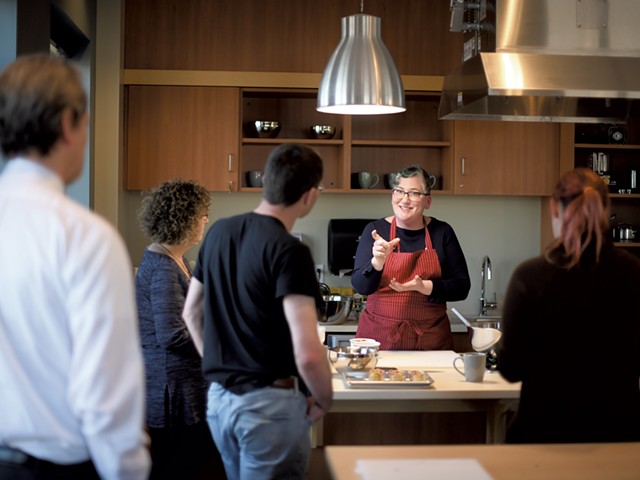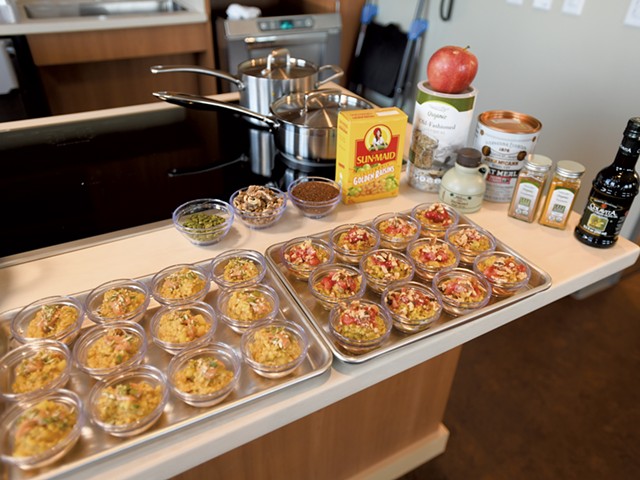Food and Wellness Go Together for UVM Medical Center Executive Chef R. Leah Pryor | Grilling the Chef | Seven Days
Chef R. Leah Pryor
- Position: Executive chef at the University of Vermont Medical Center
- Location: Burlington
- Age: 44
- Cuisine type: Farm-to-institution, from-scratch meals for patients, staff and visitors served through room service and several on-site cafés
- Education: Culinary Institute of America
- Experience: Executive chef, Fog Island Café (now Keepers/Fog Island Restaurant), Nantucket, Mass.; chef, Mary’s Restaurant at Baldwin Creek, Bristol, Vt.; pastry chef, Tourterelle, New Haven, Vt.
- What’s on the menu? Maple-roasted tofu wrap with kale slaw; Southwestern chicken bowl with black beans, rice, coleslaw, cilantro-lime dressing and avocado cream; herb pita-crusted white fish
R. Leah Pryor had just graduated from high school when she got her first cooking job: making pasta at a farm-to-table restaurant 45 minutes north of New York City.
It was the early 1990s, and Pryor had recently returned to the U.S. after living in Europe. “I just was this kind of crazy 18-year-old. I had no thought of going to college,” she recalled with a chuckle. “I was like, Whatever. I was just in Europe forever. I am a classically trained musician. I speak languages. I don’t need anything like that.”
Her parents said fine, but she needed to get a job. “That’s how it all started,” Pryor said.
After 15 years as a chef in restaurants, Pryor, 44, moved to dining and nutrition services at the University of Vermont Medical Center, where she has spent the past decade. She started as a line chef, and then created a new role for herself: chef-educator.
In July 2020, Pryor was promoted to executive chef, one of the top management positions on a team of about 200 that runs the hospital food service operation. In a normal year without a pandemic or cyberattack, that group plans, sources, cooks and serves more than 2 million meals for patients, staff and visitors.
Back when she was 18, Pryor had no idea that she was stepping onto her permanent career path or where it would take her.
“Being a chef, you think of cooking on the line or running a restaurant,” she said, “but I’ve done so many things that I would never have thought, like writing grants, performing research, running our culinary medicine program, working with dietitians.”
Pryor spoke with Seven Days about her passion for helping people feel comfortable in their kitchens, using food as medicine, and tips for eating more vegetables.
SEVEN DAYS: This interview will bein the Seven Days Wellness issue. What does wellness mean to you?
R. LEAH PRYOR: Wellness means connection to food. There has been a loss of connection to food and how we incorporate it into our lives. People say, “You need to eat well,” but then there’s really nobody saying, “Well, how do we do this? How can you start cooking for [yourself]? How can you access these [healthy] foods that we talk about?”
A lot of people, a lot of educators and a lot of chefs say, “Oh, it’s easy. Just do this.” They forget, actually, how hard that is for people.
When I think about wellness, I think, How do I help people get to that? A lot of times I’m not really teaching people how to cook; I’m actually just holding space for them to feel safe to reconnect to their kitchen.
SD: For you, personally, what does wellness look like?
RLP: I would have to say equilibrium.
“Wellness” is also a loaded word for me. I really do feel that we have to meet everybody at their level of wellness; it shouldn’t just be a dictated wellness.
SD: You’d been cooking professionally for 15 years when you started working at the hospital in 2010. How’d you land there?
RLP: I was one of the head chefs at Mary’s at Baldwin Creek. I had been there for five years and was recently pregnant and running the kitchen. I realized that those two things weren’t going to mesh.
I had a friend who was a chef who worked at the hospital, and he said, “You should look into food service.” I basically looked at him like he was crazy, because I was this powerful, fantastic chef and I would never wear a hairnet or [catch] myself dead in food service. [Laughing]
But as I became a new mother and then also newly single, I realized I had to find something where I could create work-life balance. Finding the hospital was really a lifesaver in many ways, because I was then able to really focus on how I [could] start to change the food system. And here I am 10 years later leading that [kind of change].
SD: What does the job look like on a daily basis?
RLP: It’s a lot of “people solving,” as I like to say. There’s five of us who manage the nutrition [services] department. I am in charge of supervisors who then are in charge of the staff that runs the great machine of the kitchen here at the hospital. I have a gaggle of 33 line chefs, six prep cooks, two sous chefs and one buyer.
I’m pretty far removed from the actual physicality of cooking, but 2021 is going to be the year that we change our patient menu. We’re going to be involved in a lot of [research and development]. We’re going to change the way we do food here.
SD: What kinds of things will change?
RLP: We’re still in process, but first of all, looking at the demographics of the hospital, making sure that we are able to meet the needs of our community, making sure there’s equity throughout the menu. Also, making sure that we’re able to continue our sustainability aspects, because that is a huge pillar in our menu planning and how we support the community, including local farmers and food producers.
SD: What does equity look like on a menu?
RLP: We have an ever-changing demographic here at the hospital. We want to have culturally appropriate food that is something [patients] want to eat, while making sure we are creating nourishment that is going to help. Instead of stuffed shells, you might see a curry that has a lean protein served with rice and then a garnish. The key is making food that’s going to help heal our patients.
SD: Before you became executive chef, you pioneered a new role at the hospital: chef-educator. Can you explain that?
RLP: I knew that I loved teaching, and I started to talk to one of the dietitians at the hospital about teaching together. We kind of joke that chefs and dietitians are on the opposite ends but still [provide] the same thing in the end.
We started teaching 12 classes a year to staff and patients on top of our full-time jobs. We wrote a grant and were awarded $100,000 to get that culinary medicine program off the ground.
All classes were offered with the dietitian and the chef-educator so that we always had the culinary competency aspect of things, as well as the nutrition advice.
The chef-educator is the sugar that makes the medicine go down. You put a chef in the room with a dietitian, [and] all of a sudden people kind of relax. They’re like, “This person is not going to tell me that I need to eat this kale. I don’t like kale.” But the chef-educator will say, “Maybe I can show you how to make kale that you might like.”
SD: Those two terms — “culinary competency” and “culinary medicine” — what do they mean?
RLP: Culinary competencies are a big thing: how we hold our knives, the tools that we use, giving people permission to modify recipes, talking about methods versus recipes.
I do a lot of talking about roadblocks and cooking. People will take a recipe, and most of it they don’t even understand. Like, “What is sauté? How do I properly sauté?” Or “What is a chiffonade?” Why are we using these words? [People] already kind of feel like they’re a failure by just being defeated by a recipe.
Every class I teach, I start off with a demonstration of how we hold our knives and how we cut an onion. These are the tools that open the doors for creating confidence in people.
I look at culinary medicine as blending what nutrition offers with these kinds of practical tools [in a way that will] actually benefit your life and your health.
Food is medicine, but a lot of doctors and a lot of [health care] practitioners will say, “Well, no, it’s not.”
Teaching somebody the tools of how to cook will help them with their overall health. That’s a fact. There are many tools in a [health care] practitioner’s tool belt. I just want practitioners to start using us as a tool.
SD: We all know that we should eat more vegetables. Got any tips?
RLP: Green up your breakfast. Throw as many veggies as you can in that breakfast. If you’re going to have eggs, put some spinach in there. I used to do a great kale bowl for breakfast with quinoa and blueberries, Greek yogurt and marinated kale.
SD: Root vegetables are mostly what’s in season locally right now. Any fresh ideas for them?
RLP: My favorite is to make pancakes. Grate up your root vegetables, season them, throw some fresh herbs in. A nice little pan-fry; serve it with herby yogurt, and you’ll be good to go.
This interview has been edited and condensed for clarity and length.



